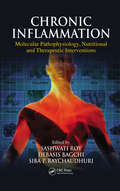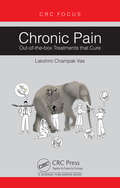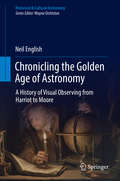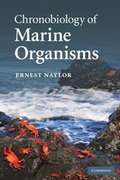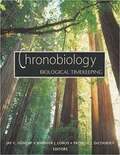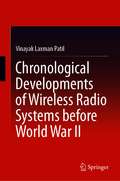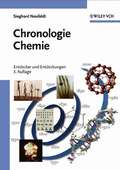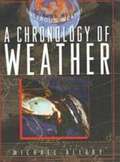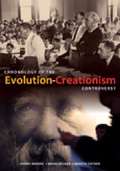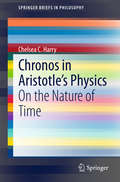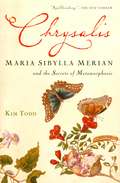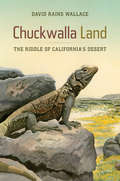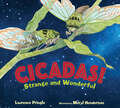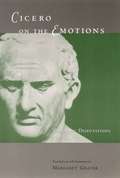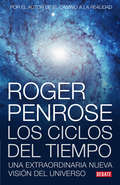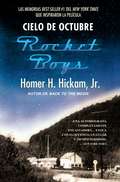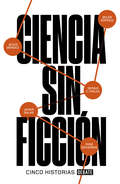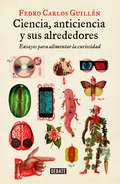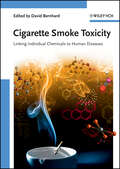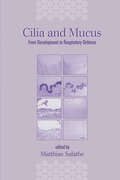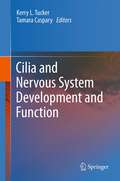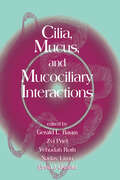- Table View
- List View
Chronic Inflammation: Molecular Pathophysiology, Nutritional and Therapeutic Interventions
by Debasis Bagchi Siba P. Raychaudhuri Sashwati RoyAlthough acute inflammation is a healthy physiological response indicative of wound healing, chronic inflammation has been directly implicated in a wide range of degenerative human health disorders encompassing almost all present day non-communicable diseases including autoimmune diseases, obesity, diabetes and atherosclerosis. Chronic Inflammation
Chronic Pain: Out-of-the-box Treatments that Cure
by Lakshmi Champak VasThe book will reassure those suffering from chronic pain and readers that pains can be treated, and not just be ‘managed’. Contemporary pain management comprises some very sophisticated treatments, which address various parts of the nervous system that have been historically assumed to be responsible for pain. The author's approach is that all neuropathic pains are neuromyopathic with a major muscle pain component where the muscles are the final common factor in all chronic pains. This premise led to the innovation of a new system of pain management, which has been gratifyingly effective, providing cures for many complicated conditions. The book is about the discovery that many types of chronic pain are curable and others easily manageable. The novel concepts developed by the author and her research on pain management are described in this book. These are unique, and will be of interest to doctors, researchers, students, and patients.
Chronicling the Golden Age of Astronomy: A History of Visual Observing from Harriot to Moore (Historical & Cultural Astronomy)
by Neil EnglishThe invention of the telescope at the dawning of the 17th century has revolutionized humanity's understanding of the Universe and our place within it. This book traces the development of the telescope over four centuries, as well as the many personalities who used it to uncover brand-new revelations about the Sun, Moon, planets, stars and distant galaxies.Starting with early observers such as Thomas Harriot, Galileo, Johannes Hevelius, Giovanni Domenico Cassini, Robert Hooke and Christian Huygens, the book explores how these early observers arrived at essentially correct ideas concerning the objects they studied. Moving into the 18th and 19th centuries, the author describes the increasing sophistication of telescopes both large and small, and the celebrated figures who used them so productively, including the Herschels, Charles Messier, William Lassell and the Earls of Rosse.Many great discoveries were also made with smaller instruments when placed in the capable hands of the Struve dynasty, F.W. Bessel, Angelo Secchi and S.W Burnham, to name but a few. Nor were all great observers of professional ilk. The book explores the contributions made by the 'clerical astronomers,' William Rutter Dawes, Thomas William Webb, T.E.R Philips and T.H.E.C Espin, as well as the lonely vigils of E.E. Barnard, William F. Denning and Charles Grover. And in the 20th century, the work of Percival Lowell, Leslie Peltier, Eugene M. Antoniadi, Clyde Tombaugh, Walter Scott Houston, David H. Levy and Sir Patrick Moore is fully explored.Generously illustrated throughout, this treasure trove of astronomical history shows how each observer's work led to seminal developments in science, and providing key insights into how we go about exploring the heavens today.
Chronobiology of Marine Organisms
by Ernest NaylorDo intertidal organisms simply respond to the rise and fall of tides, or do they possess biological timing and navigation mechanisms that allow them to anticipate when conditions are most favourable? How are the patterns of growth, development and reproduction of some marine plants and animals related to changes in day-length or to phases of the moon? The author describes how marine organisms, from single cells to vertebrates, on sea shores, in estuaries and in the open ocean, have evolved inbuilt biological clockwork and synchronisation mechanisms which control rhythmic processes and navigational behaviour, permitting successful exploitation of highly variable and often hostile environments. Adopting a hypothesis-testing and experimental approach, the book is intended for undergraduate and postgraduate students of marine biology, marine ecology, animal behaviour, oceanography and other biological sciences and also as an introduction for researchers, including physiologists, biochemists and molecular biologists entering the field of chronobiology.
Chronobiology: Biological Timekeeping
by Jay C. Dunlap Jennifer J. Loros Patricia J. DeCourseyThe study of how solar- and lunar-related rhythms are governed by living pacemakers within organisms constitutes the scientific discipline of chronobiology. Parallel to the familiar spatial cellular structure of living cells, temporal, or time, organization is a vital part of the survival and normal functioning of every species. Adaptations evolved by organisms to cope with regular geophysical cycles in their environment are evident in nearly every aspect of their lives. In fact, biological timekeeping is a core property of life on a revolving planet. Few fields encompass the breadth of science that is associated with chronobiology. Chronobiologists are at the cutting edge of fields ranging from microbial genetics to ethology to treatment of human psychiatric illnesses. Recognizing that no individual could do justice to the field in writing a comprehensive text, a group of editors with a wide range of experience has collaborated to produce Chronobiology. Chapters have been planned and written by the editors and by teams of specialists. <p><p> The text begins with a general introduction to the formalisms and vocabulary that describe circadian rhythmicity. The behavioral and ecological importance of rhythms is introduced, followed by discussion of the theoretical bases of the fundamental properties that define a circadian rhythm. Circannual rhythms and photoperiodic responses in plants and animals are examined next. A central block of four chapters develops the comparative anatomy, physiology, genetics, and molecular biology of organisms with circadian clocks. Examples at all levels of organization are drawn from the real world and from current and classic research. A pair of chapters then develops the basic circadian organization of human beings and the relevance of circadian biology to human welfare. A final chapter looks to the future by exploring six cutting-edge areas of research. <p><p> The book's highly readable style reduces technical terminology to a minimum and does not require background in neuroscience or mathematics. Illustrations and photographs are used liberally to elucidate conceptually difficult points, and the text makes use of actual data sets to explain basic principles. A collection of color plates condenses the overarching themes of the book into four colorful collages.
Chronological Developments of Wireless Radio Systems before World War II
by Vinayak Laxman PatilThis comprehensive and authoritative volume traces the history of research leading to the development of the wireless radio systems. It discusses the methods adopted by a large number of inventors and the results they obtained to provide perspective on how historical methods and events can be a source of inspiration for future research. This book will be of interest to researchers and students in telecommunications engineering as well as to teachers of history of science and technology.
Chronologie Chemie: Entdecker und Entdeckungen
by Sieghard NeufeldtZwei ereignisreiche Jahrhunderte liegen zwischen der Geburt der modernen Chemie um das Jahr 1800 und der Chemie des dritten Jahrtausends. Während dieser Zeitspanne ist die Chemie von einem Kuriosum für wenige Eingeweihte zu einem unverzichtbaren Motor der wissenschaftlichen und technischen Entwicklung geworden. Die Chemie hat Hungernöte abgewendet (so in Japan in den 1950er Jahren) und Umweltkatastrophen ausgelöst (wie nach der Freisetzung von Dioxin im italienischen Seveso 1976). Der Autor des vorliegenden Buches, selbst ein promovierter Chemiker, hat unvoreingenommen und mit einem Blick für die historische Dimension die Entwicklung dieser faszinierenden Wissenschaft protokolliert. Ob es um die erste wissenschaftlich exakte Darstellung der alkoholischen Gärung, die Entdeckung des Aspirins, der Azofarbstoffe oder der Hochtemperatur-Supraleitung geht - die epochemachenden Entdeckungen und Entwicklungen aus der gesamten Chemie sind hier in 1000 kurzen Artikeln zusammengefasst, chronologisch geordnet und mit den Namen der jeweils beteiligten Männer und Frauen verknüpft. Zu jeden Eintrag sind zusätzlich die wichtigsten Zitate aus der chemischen Originalliteratur angegeben, als Ausgangspunkt für eigene Recherchen. Wer nach verlässlichen und gut aufbereiteten Informationen über die Geschichte der Chemie sucht, kommt an diesem Werk nicht vorbei. "nicht nur eine Zusammenfassung wichtiger chemischer Fakten, sondern auch ein Stück Kulturgeschichte." (Frankfurter Allgemeine Zeitung)
Chronology of Weather (Dangerous Weather)
by Michael AllabyFrom the Book Jacket: A Chronology of Weather presents an overview of the dangerous weather described in preceding volumes in the series. It includes a time line of catastrophic weather events from c. 3,200 B.C. to 1997, as well as a chronology of meteorological discovery-comprising the lives and inventions of great weather scientists-from c. 340 B.c. to 1995. A Chronology of Weather also contains weather experiments that students can perform at home using ordinary household supplies, a glossary of meteorological terms, charts for wind measurement and cloud classification, and further readings suggested by the author. The Dangerous Weather series imparts fundamental weather science to readers through author Michael Allaby's vivid descriptions of extreme weather systems. The series focuses on the five most dangerous kinds of weather activity; diagrams related meteorological, climatological, and environmental basics in clear, compelling language; chronicles the history of each form of dangerous weather; and offers safety precautions for extreme weather conditions. Fully illustrated and indexed, the Dangerous Weather series is an invaluable tool for student research. Other volumes include: hurricanes tornadoes droughts blizzards floods Other books in this series are also available from Bookshare.
Chronology of the Evolution-Creationism Controversy
by Randy Moore Mark Decker Sehoya CotnerChronology of the Evolution-Creationism Controversy describes specific cultural, religious, and scientific events relevant to the evolution-creationism controversy from the first notions of creationism in ancient Egypt to the present.
Chronos in Aristotle's Physics: On the Nature of Time (SpringerBriefs in Philosophy #0)
by Chelsea C. HarryThis book is a contribution both to Aristotle studies and to the philosophy of nature, and not only offers a thorough text based account of time as modally potentiality in Aristotle's account, but also clarifies the process of "actualizing time" as taking time and looks at the implications of conceiving a world without actual time. It speaks to the resurgence of interest in Aristotle's natural philosophy and will become an important resource for anyone interested in Aristotle's theory of time, of its relationship to Aristotle's larger project in the Physics, and to time's place in the broader scope of Aristotelian natural science. Graduate students and scholars researching in this area especially will find the authors arguments provocative, a welcome addition to other recent publications on Aristotle's Treatise on Time.
Chrysalis: Maria Sibylla Merian and the Secrets of Metamorphosis
by Kim ToddThe award-winning science and history writer “gives wings to the life of the artist/naturalist Maria Merian. A lovely and exhilarating book” (Deidre McNamer, author of Aviary).Before Darwin, before Audubon, there was Maria Sibylla Merian.An artist turned naturalist known for her botanical illustrations, Merian was born just sixteen years after Galileo proclaimed that the earth orbited the sun. But at the age of fifty, she sailed from Europe to the New World on a solo scientific expedition to study insect metamorphosis—an unheard-of journey for any naturalist at that time, much less a woman.When she returned, she produced a book that secured her reputation, only to have it savaged in the nineteenth century by scientists who disdained the work of “amateurs.”Exquisitely written and illustrated, Chrysalis takes us from golden-age Amsterdam to the Surinam tropics to modern laboratories where Merian’s insights fuel a new branch of biology. Kim Todd brings to life a seventeenth-century woman whose boldness and vision would still be exceptional today.“In this spellbinding biography, Todd interweaves the life of Maria Sibylla Merian, a German artist and naturalist who became famous in the seventeenth century for her engravings of caterpillars, with the intellectual and scientific history of metamorphosis.” —The New Yorker“Fascinating reading about a little-known, independent woman.” —Science“What makes Chrysalis such a pleasure is that our awe is guided by Merian’s discoveries. Her life was dedicated to understanding and depicting the science of transformation, yet she never lost her enchantment with what few of us could deny is also miraculous.” —Orion
Chuckwalla Land
by David Rains WallaceDescribed as "a writer in the tradition of Henry David Thoreau, John Muir, and other self-educated seers" by the San Francisco Chronicle, David Rains Wallace turns his attention in this new book to another distinctive corner of California--its desert, the driest and hottest environment in North America. Drawing from his frequent forays to Death Valley, Red Rock Canyon, Kelso Dunes, and other locales, Wallace illuminates the desert's intriguing flora and fauna as he explores a controversial, unresolved scientific debate about the origin and evolution of its unusual ecosystems. Eminent scientists and scholars appear throughout these pages, including maverick paleobiologist Daniel Axelrod, botanist Ledyard Stebbins, and naturalists Edmund Jaeger and Joseph Wood Krutch. Weaving together ecology, geology, natural history, and mythology in his characteristically eloquent voice, Wallace reveals that there is more to this starkly beautiful landscape than meets the eye.
Cicadas!: Strange and Wonderful (Strange and Wonderful)
by Laurence Pringle"Definitely the best cicada book for kids. Adults will appreciate it as well, as it is well written, factually accurate, and beautifully illustrated." —Cicadamania.com Discover why cicadas are all the buzz in the most complete, comprehensive book for kids about these noisy but harmless insects.Every year, annual cicadas emerge and pierce the air with their buzzing calls. Also every year, at least one brood of 13 or 17 year cicadas emerges in some part of the eastern or central United States. In Spring 2021, a group of 17 year periodical cicadas called Brood X will make their appearance in the Mid-Atlantic region of the United States. Author Laurence Pringle and illustrator Meryl Henderson have created the story of this fascinating and often misunderstood insect, one that deserves to be protected.
Cicero on the Emotions: Tusculan Disputations 3 and 4
by Marcus TulliusThe third and fourth books of Cicero's Tusculan Disputations deal with the nature and management of human emotion: first grief, then the emotions in general. In lively and accessible style, Cicero presents the insights of Greek philosophers on the subject, reporting the views of Epicureans and Peripatetics and giving a detailed account of the Stoic position, which he himself favors for its close reasoning and moral earnestness. Both the specialist and the general reader will be fascinated by the Stoics' analysis of the causes of grief, their classification of emotions by genus and species, their lists of oddly named character flaws, and by the philosophical debate that develops over the utility of anger in politics and war. Margaret Graver's elegant and idiomatic translation makes Cicero's work accessible not just to classicists but to anyone interested in ancient philosophy and psychotherapy or in the philosophy of emotion. The accompanying commentary explains the philosophical concepts discussed in the text and supplies many helpful parallels from Greek sources.
Ciclos del tiempo: Una extraordinaria nueva visión del universo
by Roger PenroseUna extraordinaria nueva visión del universo. La revolucionaria y exitosa obra de Roger Penrose El camino a la realidad presentaba una guía completa y comprensible de las leyes que rigen el universo desde nuestro conocimiento actual. En Ciclos del tiempo, su libro más ambicioso, Penrose va mucho más allá: desarrolla una visión inédita de la cosmología y propone una respuesta inesperada a la pregunta "¿Qué pasó antes del Big Bang?". Las dos ideas clave que hay detrás de esta nueva visión son un penetrante análisis de la Segunda Ley de la termodinámica (que establece el principio de la entropía) y el estudio de la geometría de conos de luz del espacio-tiempo. Penrose logra combinar estos dos temas para demostrar que el destino último de nuestro universo en expansión y aceleración puede ser visto como el "big bang" de uno nuevo. Por el camino, nos explica muchos otros ingredientes básicos de esta idea y comenta varios modelos cosmológicos, tanto ortodoxos como heterodoxos, así como el papel fundamental y ubicuo de la radiación cósmica de microondas. Otra parte crucial de su exposición es la relativa a los inmensos agujeros negros detectados en los centros de las galaxias, y su eventual desaparición a través del misterioso proceso de evaporación de Hawking. Una obra fundamental para todos los amantes de la ciencia Reseñas:«El camino a la realidad es una innovación radical en la divulgación científica. En primer lugar porque desafía de manera flagrante y sistemática la ley de Hawking: "Cada ecuación que introduces en un libro reduce las ventas a la mitad"... El camino a la realidad es, simple y llanamente, una invitación a todo el mundo que quiera subirse al carro de la ciencia contemporánea.»Javier Sampedro, Babelia «El optimismo de Penrose es contagioso. Lo cierto es que a quien se atreve con este libro se le exige un enorme esfuerzo que tiene una incomparable recompensa: lo que aquí se cuenta es la aproximación más perfecta que se tiene de la realidad. El aparato construido para llevar a cabo esta proeza es uno de los productos más sublimes que puede aportar la mente humana como tarjeta de visita... la satisfacción intelectual está garantizada.»Leer «Aquellos interesados en los secretos del universo y su inquietante pasado, presente y futuro no pueden perderse este fascinante relato del gran divulgador de la astrofísica contemporánea.»La Razón
Cielo de octubre (Rocket Boys)
by Homer HickamAsí comienza la maravillosamente entretenida y extraordinaria autobiografía de la vida de «Sonny» Homer Hickam, Jr. en Coalwood, Virginia Occidental, un pueblo miserable donde lo único que importaba era la minería de carbón y el fútbol americano. El segundo hijo introspectivo del superintendente de la mina y de una madre decidida a alcanzar una vida mejor para su hijo, Sonny se unió a un grupo de inadaptados para quienes el futuro parecía incierto. Pero en 1957, luego de haber visto el satélite soviético Sputnik cruzar el cielo de los Apalaches, Sonny y sus amigos adolescentes tomaron el futuro en sus manos, cambiando sus vidas y su ciudad para siempre.Recordando una carrera distinguida en la NASA que hizo realidad los sueños de su niñez, Hickam relata la historia de su juventud, llevando a los lectores a la vida de aquel pueblo minero y las de los muchachos que encarnaron sus tensiones y sus sueños. Con la ayuda —y en ocasiones los obstáculos— de los habitantes de Coalwood, los jóvenes aprendieron no solo a convertir escombros de minería en cohetes que surcaban los cielos, sino que encontraron esperanza en una ciudad en la que el progreso pasaba desapercibido.Una autobiografía única, Cielo de octubre es a la vez una crónica inspiradora de triunfo y una historia luminosa del amor de una madre, los temores de un padre y la vida de un joven.Con la sencilla gracia de un narrador por naturaleza, Homer Hickam capta a la perfección un momento en el cual un pueblo agonizante, una familia dividida y una banda de adolescents soñadores se atrevieron a mirar más allá de sus diferencias y a fijar sus objetivos en las estrellas... y vieron un futuro que la nación estaba apenas empezando a imaginar.
Ciencia sin ficción: Cinco historias
by Jesús MéndezUn compendio indispensable que nos acerca a la cara más humana de la ciencia. Ciencia sin ficción es un título, un concepto y una declaración de intenciones que parte de dos ideas complementarias: por un lado, se basa en la convicción de que la ciencia es un terreno fértil y poco explorado donde aprovechar lo que el Nuevo Periodismo llamó en su día literatura de no ficción; por otro, se asienta en la creencia de que son muy pocos los relatos o novelas que consideran la ciencia como paisaje o motor, más allá de los encuadrados dentro de una imaginaria, distópica o alternativa ciencia ficción. Con estas premisas en mente, esta obra recoge cinco historias esencialmente narrativas: los orígenes y las implicaciones de la tecnología CRISPR para la revolución genética; una conversación con Pedro Duque sobre su primer viaje espacial; un alegato personal y general contra las irracionalidades de las pseudociencias; un viaje desde los orígenes de la física cuántica hasta Instagram, y una conversación de ficción sobre la inteligencia artificial más actual y sus algoritmos y consecuencias. Las firman el médico, científico y periodista Jesús Méndez; el bioquímico y periodista Pere Estupinyà; el periodista Javier Salas; el astrofísico, poeta y periodista Sergio C. Fanjul, y la escritora Belén Gopegui. Ciencia sin ficción se propone agrupar caminos para, con ello, reforzarlos. Pretende ser, más allá de una declaración de intenciones, un impulso, una etiqueta de reunión.
Ciencia, anticiencia y sus alrededores: Ensayos para alimentar la curiosidad
by Fedro Carlos GuillénEl conocimiento científico no es un tesoro reservado a personas con inteligencias superiores, sino algo a lo que cualquiera con sentido común puede acceder. Para demostrarlo, aquí se reunen algunas de las inquietudes de Fedro Carlos Guillén, científico y escritor, cuya intención es compartir su curiosidad con los lectores de una manera fresca y personal. Cada artículo es abordado con un estilo jovial y a veces irónico. Al tiempo que nos informa sobre los avances y algunas ideas curiosas de los procesos científicos, toma la palabra para pronunciarse sobre temas polémicos, invitando al lector a formar su propia opinión. Los hechos y posibilidades de la genética, los retos de la inteligencia artificial, la urgencia del cambio climático, el problema de las seudociencias, el éxito de los suicidas, la biología del amor y el sexo entre quienes dicen practicar el celibato, así como los aciertos y desaciertos de la propia ciencia, son algunos de ellos.
Ciencias (Edicion para Texas)
by Timothy Cooney Karen L. Ostlund Michael Anthony Dispezio Barbara K. Foots Kate Boehm Nyquist Angie L. MatamorosA Science Textbook in Spanish
Ciencias (Edicion para Texas, Grade 4)
by Timothy Cooney Karen L. Ostlund Michael Anthony Dispezio Barbara K. Foots Kate Boehm Nyquist Angie L. MatamorosSpanish Science Textbook.
Ciencias y Technologia (Grado #6)
by Holt Rinehart Winston StaffSpanish textbook on science and technology.
Cigarette Smoke Toxicity: Linking Individual Chemicals to Human Diseases
by David BernhardSmoking causes and contributes to a large number of human diseases, yet due to the large number of potentially hazardous compounds in cigarette smoke -- almost 5,000 chemicals have been identified, establishing the link between smoking and disease has often proved difficult. This unbiased and scientifically accurate overview of current knowledge begins with an overview of the chemical constituents in cigarette smoke, their fate in the human body, and their documented toxic effects on various cells and tissues. Recent results detailing the many ways components of cigarette smoke adversely affect human health are also presented, highlighting the role of smoking in cardiovascular, respiratory, infectious and other diseases. A final chapter discusses current strategies for the treatment and prevention of smoking-induced illness. Despite the obvious importance of the topic, this is the first comprehensive reference on tobacco smoke toxicity, making for essential reading for all toxicologists and healthcare professionals dealing with smoking-related diseases.
Cilia and Mucus: From Development to Respiratory Defense
by Matthias SalatheThis book details advances in research regarding cilia, mucus, and mucociliary clearance, examining changes in mucus expression and goblet cell metaplasia, and assessing the ability of the mucociliary system to respond to abnormalities. Recognizes that cilia and dynein arms play pivotal roles in developing mammalian embryos!Examines the rol
Cilia and Nervous System Development and Function
by Tamara Caspary Kerry L. TuckerCilia are tiny microtubule-based organelles projecting from the plasma membrane of practically all cells in the body. In the past 10 years a flurry of research has indicated a crucial role of this long-neglected organelle in the development and function of the central nervous system. A common theme of these studies is the critical dependency of signal transduction of the Sonic hedgehog, and more recently, Wnt signaling pathways upon cilia to regulate fate decisions and morphogenesis. Both primary and motile cilia also play crucial roles in the function of the nervous system, including the primary processing of sensory information, the control of body mass, and higher functions such as behavior and cognition, serving as "antennae" for neurons to sense and process their environment. In this book we describe the structure and function of cilia and the various tissues throughout the brain and spinal cord that are dependent upon cilia for their proper development and function.
Cilia, Mucus, and Mucociliary Interactions
by Gerald L. Baum Zvi Priel Yehudah Roth Nadav Liron Ervin OstfeldWritten by nearly 60 of the world's leading investigators in this rapidly expanding field, this state-of-the-art reference furnishes detailed presentations on the basic science and clinical aspects of cilia, mucus, and mucociliary interactions. Providing stimulating coverage of the latest information in a single source, Cilia, Mucus, and Mucoci
